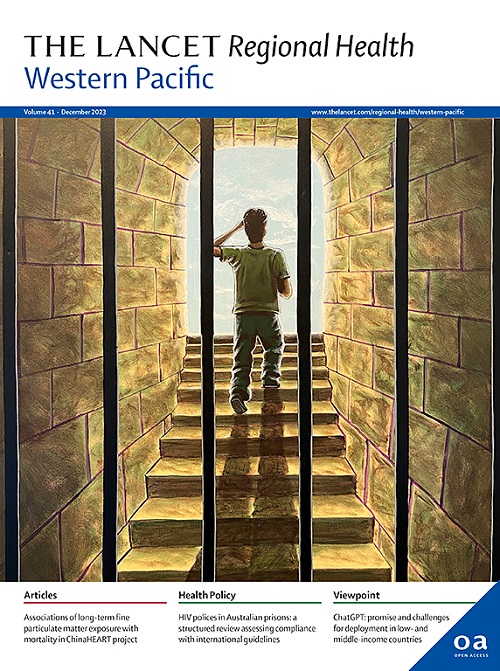Sociodemographic heterogeneity in the association between social isolation and all-cause mortality among Japanese older adults: JAGES longitudinal panel study
IF 8.1
1区 医学
Q1 HEALTH CARE SCIENCES & SERVICES
引用次数: 0
Abstract
Background
Social isolation has been linked to higher mortality; however, it remains unknown how this association varies across individuals and social groups.
Methods
We used a nationwide cohort study of ∼20,000 older adults with a 9·4-year follow-up period (Japan Gerontological Evaluation Study, 2013–2022), adjusting for 60 pre-baseline covariates. We also used a national insurance database to ascertain 4299 all-cause deaths. Using a causal machine-learning method, we estimated the heterogeneous association between social isolation and mortality.
Findings
Social isolation was more prevalent among those with lower education and income and associated on average with 69·5-day shorter survival time (restricted mean survival time [RMST] difference; 95% CI: −111, −28·4). There was evidence of heterogeneity where social isolation was associated with even shorter survival days in some subgroups (e.g., −205 days among the bottom quintile of the estimated RMST differences [95% CI: −321, −87·8]). These subgroups tended to be older, men, and have lower education. The adverse association of social isolation and mortality was particularly stronger when lower education was combined with higher income, especially among women. Individuals with lower levels of education accounted for a larger share of deaths attributable to social isolation (58·5% of excess deaths).
Interpretation
Social isolation may be more harmful among those from socially disadvantaged backgrounds, and a combination of some characteristics can synergistically amplify its effects on mortality. Proper population-level interventions informed with the evidence of effect heterogeneity might not only improve health on average but also mitigate existing health disparities.
Funding
Japan Society for the Promotion of Science, Health Labour Sciences Research Grants, Research Funding for Longevity Sciences from the National Center for Geriatrics and Gerontology, Research Institute of Science and Technology from the Japan Science and Technology, Japan Health Promotion & Fitness Foundation, Department of Active Ageing, Niigata University Graduate School of Medical and Dental Sciences, Tokyo Medical and Dental University Priority Research Areas Grant and National Research Institute for Earth Science and Disaster Resilience.
日本老年人社会孤立与全因死亡率之间的社会人口异质性:JAGES纵向面板研究
社会孤立与较高的死亡率有关;然而,这种关联在个体和社会群体之间的差异尚不清楚。方法:我们采用了一项全国队列研究,对2万名老年人进行了9.4年的随访(日本老年学评估研究,2013-2022),调整了60个基线前协变量。我们还利用国家保险数据库确定了4299例全因死亡。使用因果机器学习方法,我们估计了社会孤立与死亡率之间的异质性关联。社会隔离在受教育程度和收入较低的人群中更为普遍,平均生存时间缩短69.5天(限制平均生存时间[RMST]差异;95% CI: - 111, - 28.4)。有异质性的证据表明,在一些亚组中,社会隔离与更短的生存时间相关(例如,在RMST估计差异的最低五分之一中,- 205天[95% CI: - 321, - 87·8])。这些亚群体往往是年龄较大、受教育程度较低的男性。在低教育与高收入并存的情况下,特别是在妇女中,社会孤立与死亡率之间的不利联系尤为明显。受教育程度较低的人在归因于社会孤立的死亡中所占比例较大(占额外死亡人数的58.5%)。社会孤立可能对那些来自社会弱势背景的人更有害,一些特征的结合可以协同放大其对死亡率的影响。适当的人口水平干预措施,在了解效果异质性证据的情况下,不仅可以改善平均健康状况,还可以减轻现有的健康差距。日本科学促进会、卫生劳动科学研究基金、国家老年医学和老年医学中心长寿科学研究基金、日本科学技术研究所、日本健康促进和健身基金会、新泻大学医学和牙科科学研究生院积极老龄化部、东京医科和牙科大学优先研究领域资助和国家地球科学和灾害恢复研究所。
本文章由计算机程序翻译,如有差异,请以英文原文为准。
求助全文
约1分钟内获得全文
求助全文
来源期刊

The Lancet Regional Health: Western Pacific
Medicine-Pediatrics, Perinatology and Child Health
CiteScore
8.80
自引率
2.80%
发文量
305
审稿时长
11 weeks
期刊介绍:
The Lancet Regional Health – Western Pacific, a gold open access journal, is an integral part of The Lancet's global initiative advocating for healthcare quality and access worldwide. It aims to advance clinical practice and health policy in the Western Pacific region, contributing to enhanced health outcomes. The journal publishes high-quality original research shedding light on clinical practice and health policy in the region. It also includes reviews, commentaries, and opinion pieces covering diverse regional health topics, such as infectious diseases, non-communicable diseases, child and adolescent health, maternal and reproductive health, aging health, mental health, the health workforce and systems, and health policy.
 求助内容:
求助内容: 应助结果提醒方式:
应助结果提醒方式:


